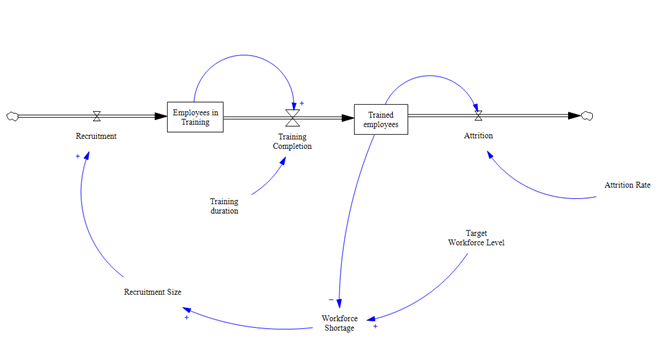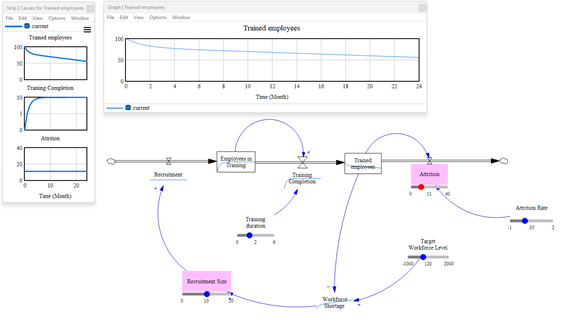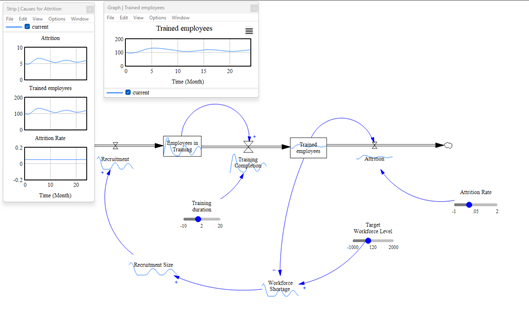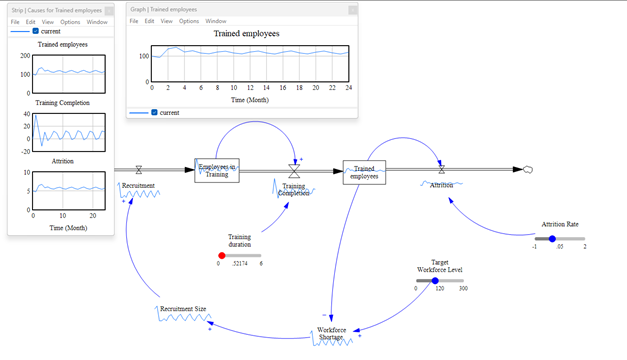Workforce Management Simulation Using System Dynamics
1. Introduction
In modern production environments, efficient workforce management is crucial to maintaining productivity and ensuring smooth operations. One common challenge is matching the available workforce to the actual staffing demand while accounting for inevitable dynamics such as employee turnover, recruitment delays, and training time. To address these challenges, this paper presents a system dynamics model developed in Vensim that simulates workforce fluctuations and provides insights into how different policy parameters affect staffing levels over time.
2. Model Overview
The model is constructed using the stock-and-flow methodology in Vensim and represents the flow of employees through stages of recruitment, training, and attrition. It is designed to evaluate how workforce levels change over time depending on recruitment policies and employee retention rates.

3. Key Components of the Model
Stocks (Levels):
· Employees in Training: Individuals currently undergoing training and not yet available for full productivity.
· Trained Employees: Fully trained workers available to perform their duties.
Flows:
· Recruitment: The inflow of new employees entering the training pipeline.
· Training Completion: The transition of employees from the training phase to becoming fully qualified.
· Attrition: The outflow of trained employees leaving the organization.
Auxiliary Variables:
· Training Duration: The average time required for a new employee to complete training.
· Attrition Rate: The percentage of trained employees who leave the workforce each month.
· Target Workforce Level: The desired number of trained employees required for optimal operations.
· Workforce Shortage: The gap between the target level and the current number of trained employees.
· Recruitment Size: The number of new hires determined dynamically based on the calculated shortage.
4. Dynamics and Feedback Loops
The model includes a key feedback loop: when the number of trained employees falls below the target level, the system increases recruitment to compensate for the shortage. However, because of the delay introduced by the training period, the system exhibits time-lagged responses. If the recruitment is too slow or the attrition rate too high, the system may experience persistent workforce shortages, leading to decreased production capacity.
5. Simulation Scenarios
Using Vensim's simulation capabilities, different scenarios can be analyzed:
Baseline Scenario: Constant attrition and static recruitment. This shows gradual decline in workforce if the recruitment size is not adjusted.

Responsive Recruitment: Recruitment is increased proportionally to the workforce shortage. This results in oscillatory behavior due to training delays, but workforce levels tend to stabilize.

Shortened Training Duration: Reducing the training period leads to quicker workforce stabilization and less severe shortages.

These simulations highlight the importance of designing recruitment policies that consider both response time and system inertia.
6. Interpretation and Implications
The simulation reveals the significance of system delays (e.g., training time) in workforce planning. Rapid changes in workforce demand require proactive strategies, as reactive hiring may not be sufficient due to the lag between hiring and training completion. Managers should regularly monitor staffing levels and trends in attrition to adjust recruitment targets before shortages impact production.
7. Conclusion
System dynamics modeling in Vensim provides a valuable tool for understanding and managing workforce fluctuations in a structured, visual, and data-driven way. The model helps decision-makers identify critical leverage points such as recruitment timing, training efficiency, and retention strategies. With further refinement, the model can be expanded to include cost analysis, productivity loss due to understaffing, or even morale-related feedbacks for a more comprehensive workforce management approach.

No Comments